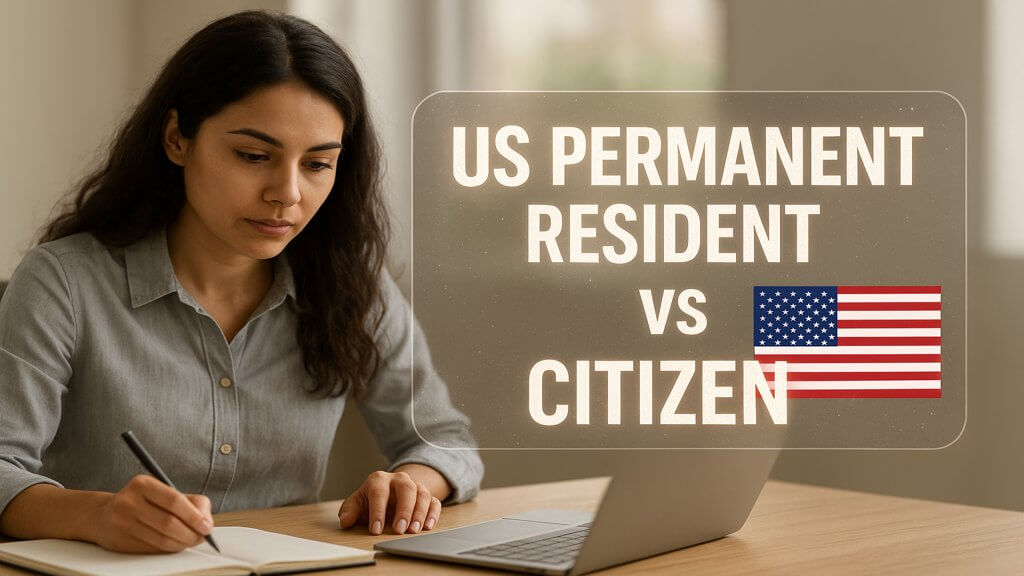The Adjustment of Status (AOS) process allows eligible non-U.S. citizens already in the United States to apply for a green card without leaving the country. It’s commonly used by those on temporary visas, like student (F-1) or work (H-1B) visas, who wish to become permanent residents.
AOS vs. Consular Processing:
- AOS: Apply for your green card while staying in the U.S.
- Consular Processing: Apply from abroad at a U.S. consulate or embassy. You remain outside the U.S. until your green card is approved.
Both options have the same eligibility rules, but timelines, forms, and fees differ.
Important Update:
- New Form I-485 requires submission of Form I-693 (medical exam) at the same time.
- Affidavit of support is streamlined.
- Questions on the public charge rule are now clearer.
Typical AOS Timelines:
| Category | Approx. Processing Time |
|---|---|
| Spouse of U.S. citizen | 8.7 months |
| Spouse of U.S. green card holder | 35 months |
| K-1 visa → AOS | 8.7 months (plus K-1 visa approval: 8–11 months) |
Processing times vary by location and individual circumstances. Check your USCIS field office for current estimates.
Check Also: Best Dating Apps and Websites for Immigrants
90-Day Rule:
- Some temporary visas (F-1, B-1/B-2) don’t allow “dual intent”.
- Adjusting status within 90 days of entry may raise questions about misrepresentation.
- Keep evidence showing genuine intent if your plans changed after arriving.
Steps to Get a Green Card via AOS:
- Check eligibility for a green card category (family, employment, humanitarian, diversity).
- File the sponsoring petition:
- Family-based: Form I-130
- Employment-based: Form I-140
- Humanitarian: Form I-730
- Petition approval: Wait for USCIS to approve your petition.
- Visa availability: Check the Visa Bulletin (except for immediate relatives of U.S. citizens).
- File Form I-485 (AOS application): Optionally include work permit and advance parole.
- Biometrics: Attend fingerprint and eye scan appointment.
- Interview: USCIS may require an in-person interview.
- Request for Evidence (if needed): Provide additional documentation if requested.
- Decision: Receive approval notice and, shortly after, your green card.
Tip: Filing Form I-130 and I-485 concurrently can save time for spouses, children, and parents of U.S. citizens.
USCIS Adjustment of Status Steps:
For many foreign nationals living in the U.S., applying for a green card through adjustment of status is the pathway to permanent residency without leaving the country. Understanding the USCIS adjustment of status steps can simplify this complex process.
Green Card Adjustment of Status
The green card adjustment of status allows eligible individuals to transition from a temporary visa to permanent resident status. Whether through family, employment, or other eligibility categories, this process ensures you can live and work in the U.S. legally.
How to File Adjustment of Status:
How to file adjustment of status starts with submitting the correct forms and supporting documents to USCIS. This includes:
- Form I-485 adjustment of status (Application to Register Permanent Residence or Adjust Status)
- Supporting forms such as Form I-130 (family-based), I-140 (employment-based), or other eligibility forms
- Evidence of your eligibility, identity, and lawful entry
Supporting Forms for Adjustment of Status:
Along with Form I-485, applicants may need additional supporting forms for adjustment of status:
- Form I-765 – Work permit application
- Form I-131 – Travel document
- Medical examination form I-693
- Affidavit of support I-864 (if family-based)
Filing the right combination ensures a smoother process and avoids delays.
Adjustment of Status Interview Preparation:
Once USCIS reviews your application, you may be called for an adjustment of status interview. Preparation is key:
- Review your application thoroughly
- Bring originals of all submitted documents
- Be ready to answer questions about your eligibility, employment, or marriage (if applicable)
Biometrics for Adjustment of Status:
As part of the process, you must attend a biometrics appointment for adjustment of status, where USCIS collects fingerprints, photographs, and signatures. This step is crucial for background and security checks.
Filing Fees for Adjustment of Status:
The filing fees for adjustment of status vary depending on your age and category but typically cover the I-485 application, biometrics, and supporting forms. USCIS publishes the current fee schedule, so check before filing.
Adjustment of Status Denial Reasons:
Applications can face challenges. Common adjustment of status denial reasons include:
- Ineligibility for the green card category
- Missing or incorrect documents
- Unlawful entry or overstays (without waivers)
- Criminal or immigration violations
Understanding these pitfalls helps you avoid mistakes and strengthens your case.
Adjustment of Status After Visa Overstay:
It’s possible to pursue adjustment of status after a visa overstay if you qualify under certain categories, such as immediate family sponsorship. Legal guidance is strongly recommended in these cases to navigate complex rules.
Adjustment of Status After Marriage:
Adjustment of status after marriage is common for spouses of U.S. citizens or green card holders. The process requires proof of a bona fide marriage, submission of supporting forms, biometrics, and an interview to confirm the legitimacy of the relationship.
AOS Costs:
| Fee | Amount |
|---|---|
| Form I-130 | $675 |
| Form I-485 (adult) | $1,440 |
| Form I-485 (child <14, with parent) | $950 |
| Refugee applicants | Fee waived |
Eligibility:
- Family-based: Spouse, child, parent, or close relative of a U.S. citizen or green card holder.
- Employment-based: Employer sponsorship or personal achievements.
- Other: Humanitarian, diversity lottery, or other grounds.
Special Cases:
- Marriage-based AOS allows applying even if you overstayed a visa, as long as your entry was lawful.
- Immediate relatives of U.S. citizens are not subject to annual green card caps.
Checking Your AOS Status:
- Track your case online using your USCIS case number.
After Receiving Your Green Card:
- You can work, travel, and live freely in the U.S.
- Conditional green cards (2-year) must be upgraded to 10-year cards.
- Citizenship eligibility: Typically 3–5 years after receiving your green card, with requirements like paying taxes and avoiding long absences from the U.S.
- Travel caution: Without advance parole, leaving the U.S. may abandon your AOS application.
Conclusion:
Adjustment of Status lets eligible immigrants already in the U.S. apply for a green card without leaving the country, offering a direct path to permanent residency. The process involves meeting eligibility requirements, filing the right forms, attending appointments, and following USCIS timelines carefully. With patience, preparation, and the right documentation, AOS can open the door to living, working, and building your future in the United States.
Frequently Asked Questions:
-
What is Adjustment of Status (AOS)?
AOS is the process that allows eligible non-U.S. citizens already in the United States to apply for a green card without leaving the country.
-
How is AOS different from consular processing?
AOS lets you apply for a green card while in the U.S., while consular processing requires applying from a U.S. embassy or consulate abroad.
-
Who can apply for AOS?
Individuals on valid visas, such as F-1, H-1B, or B-1/B-2 (with certain rules), who meet eligibility for family-based, employment-based, humanitarian, or diversity lottery green cards.





